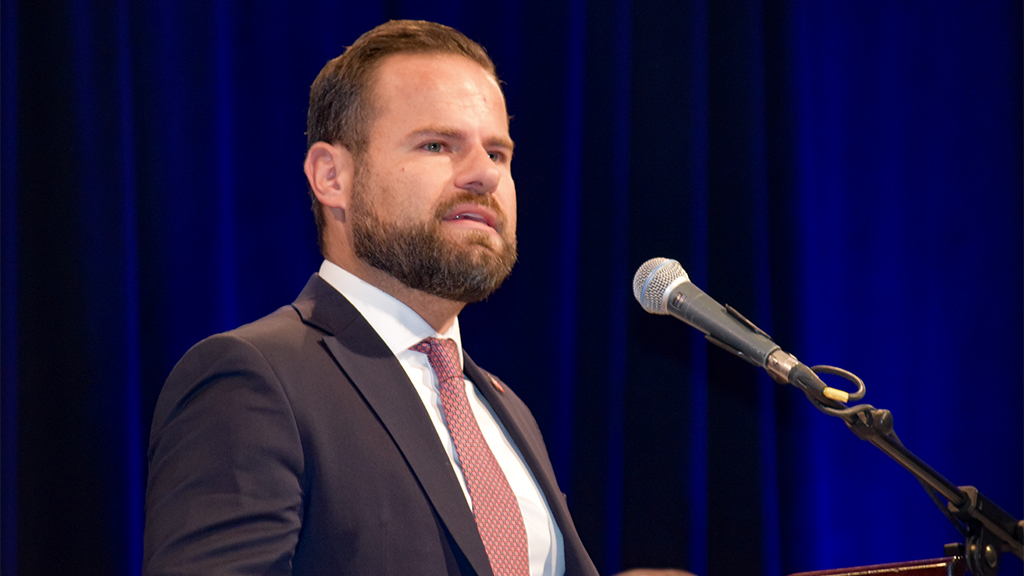It was business before pleasure for Ontario’s new Minister of Labour David Piccini and Ontario Building Trades Council business manager Marc Arsenault during the council’s recent annual convention as during a meeting they discussed aligning on an important labour forecasting program.
The new labour demand forecasting modelling tool worked superbly during a pilot program involving “granular” discussions of the scheduling of key trades as Ontario Power Generation (OPG) and Bruce Power worked on respective refurbishment projects at the same time, Arsenault said.
So with Piccini in Windsor earlier this month for an address to the Building Trades convention the next day, he and Arsenault sat down to discuss expanding the program.
Projects and owners mentioned where the scheduling of various trades could be precisely negotiated according to Arsenault include Infrastructure Ontario, Metrolinx, mining projects and Nova Chemicals near Sarnia.
In his address the next day, Piccini mentioned Ontario’s two EV battery plant projects as well.
“It’s developing a forecasting tool to predict skilled trades requirements for major construction projects across Ontario, and we’re taking a whole-of-government approach, and this is so, so critical,” said Piccini, who had been in the job two weeks at the time.
Sequencing of major projects is a good but challenging problem for Ontario’s cabinet, Piccini said.
“These two battery plants that we’re building right now aren’t just going to appear because we wish them to appear. They’re going to appear because of all of you, and this tool to help us predict the labour that we’re going to need is very exciting.
“I think this is going to be massive…we’re going to need an all-hands-on-deck approach as we’re going to fill our labour shortage and you’ve risen to the challenge.”
Piccini was assigned his new cabinet post Sept. 23 when Monte McNaughton resigned to enter the private sector. Arsenault said the new minister’s remarks indicating the ministry’s continued support for three key partnership programs with the Building Trades were welcome.
The pilot collaboration between Bruce Power and OPG involved what amounted to day-by-day scheduling of key trades, staggering them to avoid creating bottlenecks on the billion-dollar jobs, Arsenault explained. The schedule for boilermakers specifically had to be acutely managed to mitigate supply risks.
The program is based off the work done with the Electrical Power Systems Resource Council at the Darlington refurbishment.
The Building Trades modified one of its programs, Tomorrow’s Trades, to incorporate the new planning component, Arsenault said.
“We’re short X amount of workers, exactly how many millwrights, pipefitters, boilermakers, ironworkers, crane operators, exactly how many of those are required on the project? When are they required on the project and for how long do you need them?’ That’s the granular detail that was put in place on refurbishment,” he explained.
The previous minister “couldn’t get enough of” the concept as a strategy to address the problem of overall labour shortages, Arsenault said.
“That’s the understanding that we know as construction subject-matter experts, and we’re not jumping on the panic button,” he said.
The program also has potential benefits for other programs, Arsenault said, such as the purchase plans used by training delivery agents to obtain funding for apprentices, policy on immigration and temporary foreign workers, and addressing regional disparities.
Thanks in part to the success of the forecasting tool, Arsenault said, Ontario’s nuclear industry is gaining new attention around the world as refurbishments come in on time and budget. Critics, meanwhile, are being silenced.
“The whole global nuclear community is saying, ‘How can you deliver these projects 167 days ahead of schedule?’ It’s more than 10 per cent (early),” he said, noting collaboration is widespread including vendors, and the work planning is done down to the hour.
“A 900-megawatt nuclear reactor is 1,343 days from defuel to refuel. These projects are extremely complex. And with each unit, we have made incremental improvements to be ahead of schedule, under budget and the work being safely performed.”
Mary Van Buren, president of the Canadian Construction Association, said the CCA supports long-term infrastructure planning by governments as a necessary condition for ensuring that there are adequate trades available for large projects. She praised the co-operation between competitors involved in the nuclear refurbishments.
“Instead of competing with each other for these resources, they’re co-operating to share resources and to make sure that both of these projects get done,” she said.
Follow the author on Twitter @DonWall_DCN











Recent Comments
comments for this post are closed